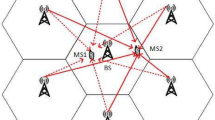Abstract
A particularly attractive feature of CDMA wireless systems proposed in the Telecommunication Industry Association's standard IS-95 [1] is their ability to get into what is known as “soft handoff”. A mobile in soft handoff maintains simultaneous radio links with multiple base-stations which enables it to make use of the best quality leg most of the time. This is believed to result in a reduction of the fade margin that is needed to provide the desired coverage in a given geographical area in the presence of log-normal shadow fading. This paper presents an analysis of fade margins for systems allowing soft handoffs (e.g. CDMA) and those where only hard handoffs are possible (e.g. FDMA, TDMA). The analysis is based on a model for hard handoffs with hysteresis and connection delay and confirms the belief that soft handoffs result in smaller fade margins.
Similar content being viewed by others
References
TIA/EIA/IS-95 Interim Standard,Mobile Station — Base Station Compatibility Standard for Dual-Mode Wideband Spread Spectrum Cellular System, Telecommunication Industry Association (July 1993).
M. Haberman, CDMA field test results for Washington D.C., Bell Atlantic Mobile Systems Report (Nov. 19, 1992).
A.J. Viterbi and R. Padovani, Implications of mobile cellular CDMA, IEEE Commun. Mag. (Dec. 1992) 38–41.
W.C.Y. Lee,Mobile Cellular Telecommunications Systems (McGraw-Hill, New York, 1989).
A.J. Viterbi, A.M. Viterbi, K.S. Gilhousen and E. Zehavi, Soft handoff extends CDMA cell coverage and increases reverse link capacity, IEEE JSAC 12 (1994) 1281–1287.
J. Skold, B. Gudmundson and J. Farjh, Performance and characteristics of GSM-based PCS,Proc. 1995 IEEE 45th Vehicular Technology Conference, Chicago, Illinois (July 1995) pp. 743–748.
R. Vijayan and J.M. Holtzman, A model for analyzing handoff algorithms, IEEE Trans. Veh. Tech. 42 (1993) 351–356.
K.M. Rege, S. Nanda, C.F. Weaver and W.-C. Peng, Analysis of fade margins for soft and hard handoffs,Proc. IEEE PIMRC'95 (September 1995).
M. Gudmundson, Correlation model for shadow fading in mobile radio systems, Electronic Lett. 27 (1991) 2145–2146.
Author information
Authors and Affiliations
Rights and permissions
About this article
Cite this article
Rege, K.M., Nanda, S., Weaver, C.F. et al. Fade margins for soft and hard handoffs. Wireless Netw 2, 277–288 (1996). https://doi.org/10.1007/BF01262047
Issue Date:
DOI: https://doi.org/10.1007/BF01262047




